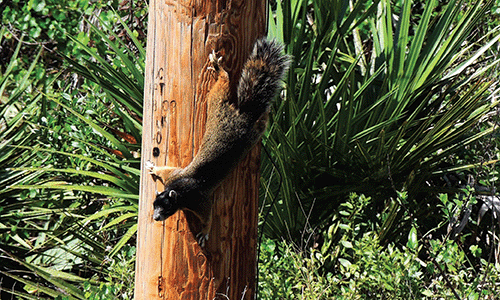By: Kara Tyler-Julian | Biologist
Have you ever seen a small mammal running through the woods and wondered to yourself, “Was that a fox? A squirrel? A badger? Chupacabra?” Well, if that furry friend looked like a very large squirrel with a long bushy tail, chances are it was the elusive fox squirrel. In Southwest Florida, there are two subspecies of the fox squirrel that you may be lucky enough to see, the Southern (or Sherman’s) fox squirrel, Sciurus niger shermani, and the Big Cypress fox squirrel, Sciurus niger avicennia.
South of the Caloosahatchee River, if you happen to spy one of these large, fluffy rodents, it is most likely the Big Cypress fox squirrel, which is a state-threatened species. These striking creatures come in a variety of different colors such as gray, buff, reddish-brown, black, or somewhere in between. This subspecies is only found at the southern end of Florida. Like other species of squirrel, the fox squirrel builds its nests in trees, but otherwise spends much of its time on the ground foraging for food. These squirrels feed on a variety of food items such as acorns, pine seed cones, cabbage palm fruit, saw palmetto berries, and many more native plant fruits and seeds. Additionally, biologists in the Big Cypress Natural Preserve conducted a study on the diet of this species and also documented the lubber grasshopper as an important food source for this species. Another reason to love the much-maligned insect featured in last month’s article.
The Big Cypress fox squirrel prefers open woodland habitats such as pine forests, cypress swamp forests, mangrove swamps, and other similar habitats that feature an open tree canopy and sparse understory. Such habitats are examples of natural Florida habitats maintained by fire, which are becoming more and more rare as they are destroyed and fragmented by the rampant development destroying much of our beautiful state. Habitat loss and destruction is one of the main threats to this and other native species.
If you want to help preserve this charismatic species and others like it, the best thing to do is support policies and organizations that prioritize the conservation and management of native habitats in this area. If you would like to encourage this species in your own yard, rather than putting out feeders full of unnatural food items, try planting more native plants in your yard that produce some of their favorite fruits: saw palmettos, cabbage palms, slash pine trees, oaks, wax myrtles, pond apples, and more, and don’t forget to keep the lubbers around for this squirrel to snack on.








